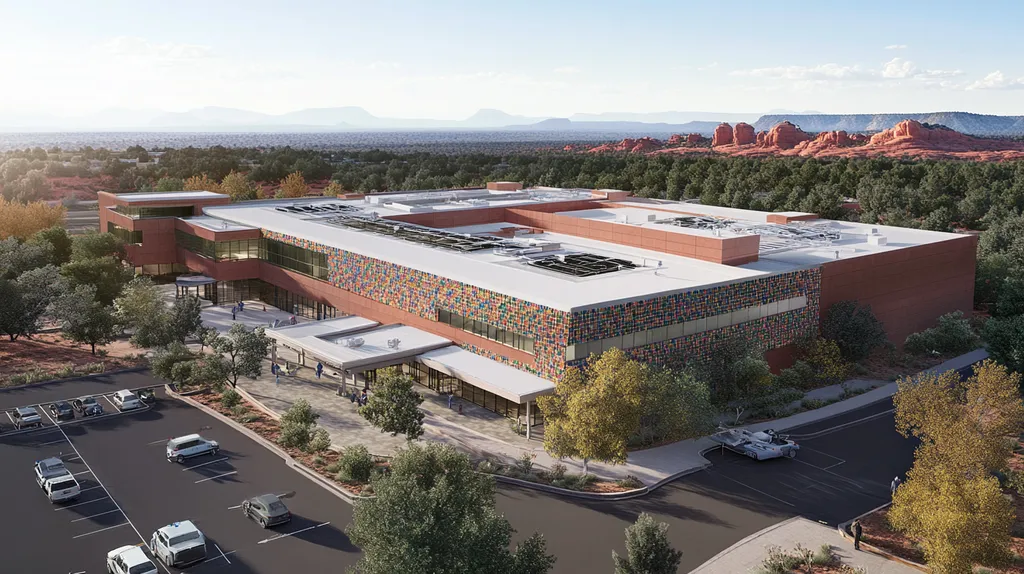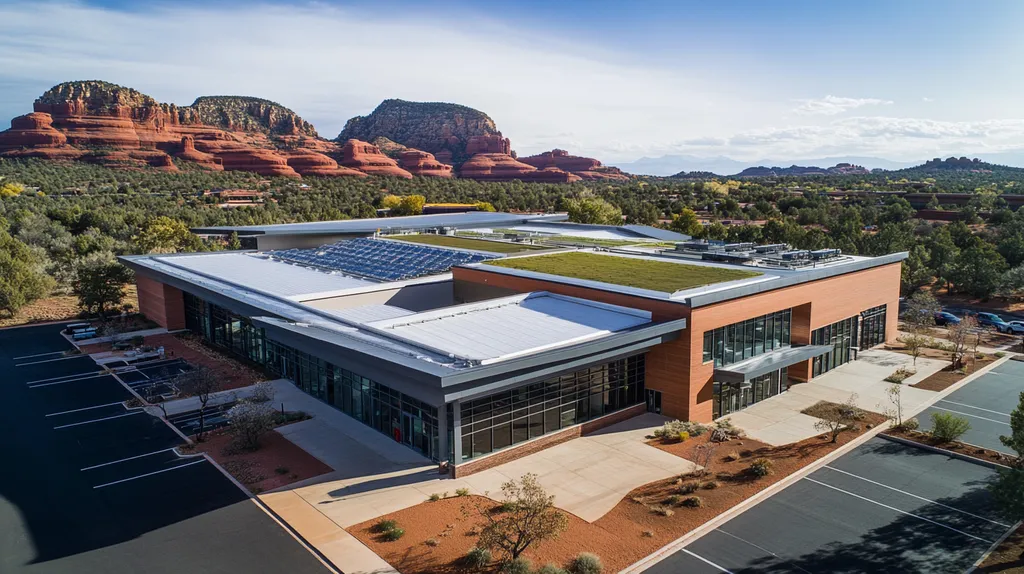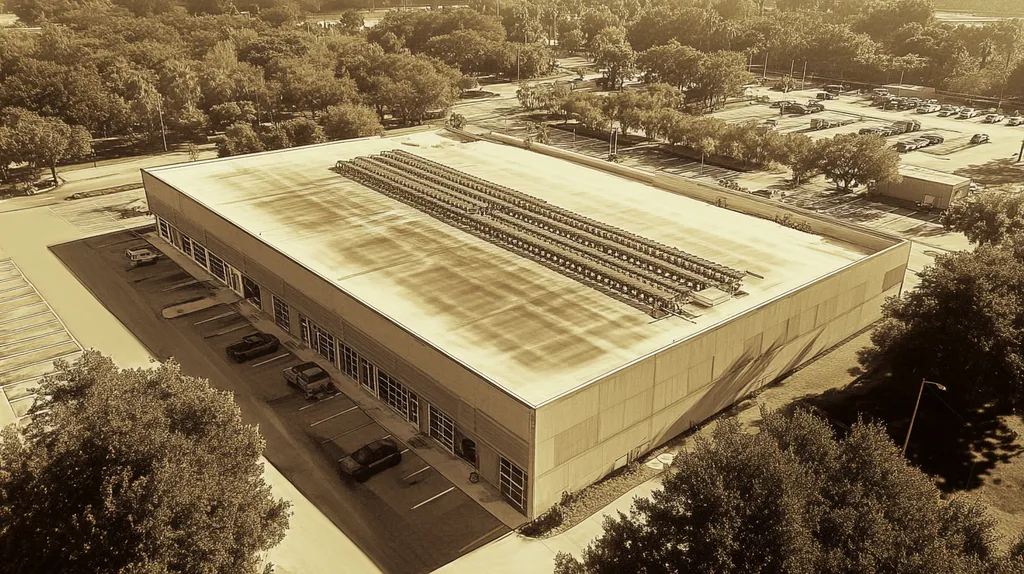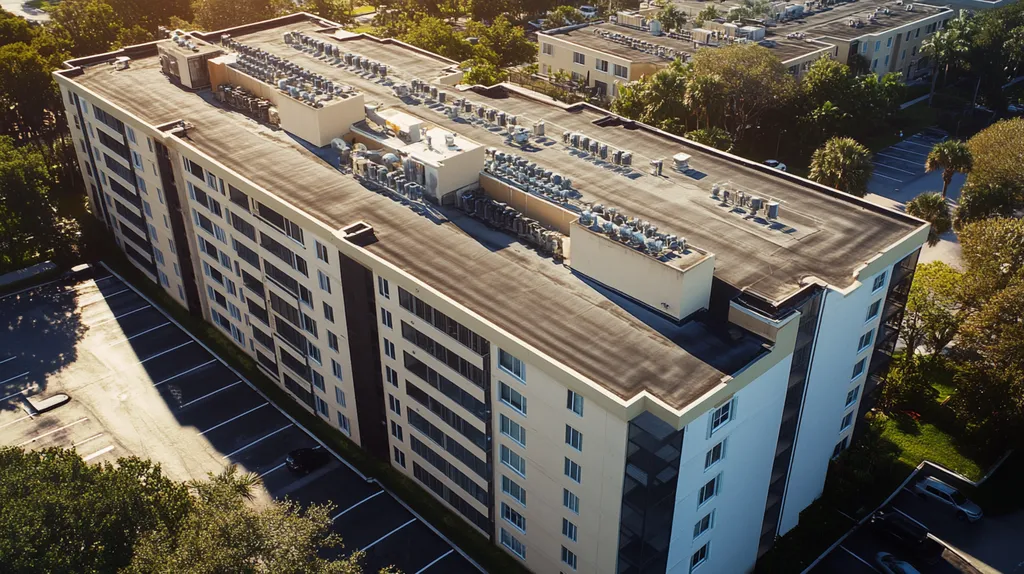Commercial roofing permit delays now cost property owners an estimated $2.8 billion annually, with projects facing up to 12 weeks of administrative holdups that threaten both building integrity and bottom lines.
While modern roofing technology races forward, permit processes remain firmly planted in the previous century, creating a bureaucratic obstacle course that challenges even seasoned professionals.
This analysis examines how fragmented requirements, outdated procedures, and missed technological opportunities combine to create a system that’s as watertight as a sieve – and proposes practical solutions to stem the flood of inefficiency.
SECTION 1: CURRENT PRACTICES
The commercial roofing permit landscape has become increasingly complex, with property owners navigating a maze of requirements that can make or break project timelines. Current estimates suggest that permit-related delays can extend project completion by 4-8 weeks, directly impacting business operations and bottom lines. Understanding these processes isn’t just about compliance – it’s about protecting investments and maintaining operational continuity.
Standard Permit Application Workflow and Documentation
Building permits are mandatory for all commercial roofing projects, whether new construction or improvements. The City of Green Bay’s requirements exemplify typical processes, where applications must include approved plans demonstrating compliance with both building and zoning codes before work can begin. (source: City of Green Bay Official Website)
Documentation requirements typically encompass structural calculations, wind uplift resistance data, and detailed material specifications. Each element requires meticulous attention, as oversights can trigger automatic rejections.
Review timelines vary significantly by jurisdiction and project scope. While minor projects might receive approval within two weeks, complex commercial installations often face extended review periods.
Many jurisdictions have implemented digital submission systems, yet these supposed improvements often introduce new complications through rigid formatting requirements and technical constraints.
Typical Fee Structures and Payment Procedures
Permit fees follow various calculation methods, from flat rates to sliding scales based on project value. Some jurisdictions employ square footage multipliers, while others use construction cost percentages.
Hidden costs lurk throughout the process, from plan review fees to inspection charges. Multiple revisions or failed inspections can double base fees, creating unexpected budget impacts.
Payment systems remain surprisingly antiquated in many jurisdictions. While some accept electronic payments, others still require certified checks or in-person transactions.
Rush processing options exist but often come with premium fees that can exceed 50% of standard rates. These expedited services rarely guarantee specific completion timeframes.
Role of Local Jurisdictions and Authority Having Jurisdiction (AHJ)
The AHJ wields considerable influence over project timelines through interpretation of building codes and enforcement protocols. Their decisions can significantly impact material choices and installation methods.
Local jurisdictions frequently modify requirements without adequate notice, creating moving compliance targets. These changes can invalidate previously approved approaches.
Coordination between multiple departments often creates bottlenecks. A single project might require sign-offs from building, fire, and environmental divisions.
Jurisdictional overlap between city, county, and state authorities frequently creates confusion about which standards apply. This ambiguity leads to defensive over-compliance and increased costs.
SECTION 2: SYSTEMIC ISSUES
When it comes to commercial roofing permits, the system isn’t just leaking – it’s suffering from structural defects. Recent industry data shows that permit-related delays now account for 35% of project timeline extensions, with costs ballooning by an average of $12,000 per month of delay. These systemic issues create a perfect storm of inefficiency that threatens both project viability and building integrity.
Inconsistent Permit Requirements Across Jurisdictions
Picture a game where the rules change every time you cross a street – that’s the reality of cross-jurisdictional roofing permits. Building permits in Green Bay illustrate this complexity, requiring separate applications for commercial projects and additional erosion control permits that may not be necessary in neighboring cities. (source: City of Green Bay Official Website)
What qualifies as a minor repair in one jurisdiction might trigger a full permit review in another. These disparities create a compliance maze that even experienced contractors struggle to navigate.
Material specifications that sail through approval in one county might face rejection in the next. This inconsistency forces contractors to maintain multiple sets of documentation and procedures.
The resulting confusion leads to costly over-engineering as contractors adopt the most stringent requirements by default, driving up costs across all projects.
Administrative Delays and Redundant Steps
The permit process often resembles a bureaucratic game of “Mother May I,” where each step forward risks sending you three steps back. Review periods that should take days stretch into weeks or months.
Sequential approvals create unnecessary bottlenecks when parallel processing would suffice. A single missing checkbox can trigger a complete restart of the review cycle.
Digital systems, rather than streamlining the process, often add another layer of complexity. Many jurisdictions maintain parallel paper and digital requirements, effectively doubling the workload.
The cost of these delays extends beyond direct expenses, as weather windows close and temporary repairs stretch beyond their intended lifespan.
Lack of Transparency and Communication in Approval Process
Tracking a permit’s progress often feels like trying to read tea leaves through a roof membrane. Status updates are rare, and when they come, they’re often cryptic.
The absence of clear timelines forces property owners to pad schedules with excessive contingency time. This uncertainty ripples through the entire project planning process.
Communication channels between departments often resemble a game of telephone, where critical information gets garbled or lost entirely. Applicants frequently receive contradictory guidance from different officials.
When problems arise, there’s rarely a clear escalation path or resolution process. Property owners find themselves bouncing between departments like a ping-pong ball in search of answers.
The resulting atmosphere of uncertainty leads to defensive over-documentation, further clogging an already strained system.
SECTION 3: MISSED OPPORTUNITIES
While the roofing industry has embraced cutting-edge materials and installation techniques, permit processes remain firmly planted in the last century. Each year, inefficient application procedures cost property owners an estimated $2.8 billion in project delays and administrative overhead. The disconnect between modern construction capabilities and antiquated bureaucracy creates three glaring missed opportunities that, if addressed, could revolutionize how we approach commercial roofing projects.
Inefficiencies from Manual Application and Paperwork
The current paper-based permit system operates with all the efficiency of a leaky gutter in a hurricane. Property owners face stacks of redundant forms, each requiring multiple copies and wet signatures, creating a paper trail that could stretch from foundation to roofline.
Basic permit applications for commercial projects in Green Bay demonstrate this bureaucratic quagmire, requiring separate long-form applications strictly for commercial projects, plus additional erosion control permits that multiply the paperwork burden. (source: City of Green Bay Official Website)
Even minor corrections trigger complete resubmissions, forcing project managers to navigate the same maze multiple times. This repetitive cycle wastes valuable time during critical weather windows when installation conditions are optimal.
The resulting bottlenecks create a domino effect of scheduling disruptions, affecting everything from material deliveries to crew availability. What should be a straightforward process becomes an exercise in patience and persistence.
Underutilization of Digital Permit Management Tools
The roofing industry’s reluctance to embrace digital permit tools mirrors the same skepticism that once greeted synthetic membranes. Despite proven benefits, only 15% of jurisdictions fully utilize available digital solutions.
Modern permit management platforms offer real-time tracking, automated notifications, and instant submission capabilities. Yet most property owners still shuffle paper forms between departments like a game of bureaucratic hot potato.
Digital systems could eliminate common submission errors through built-in validation checks. Instead, we continue to play document detective, hunting down missing signatures and misplaced attachments.
The cost of this technological hesitation extends beyond mere inconvenience. Every day spent waiting for physical paperwork to move through the system is another day exposed to potential weather damage and escalating repair costs.
Failure to Leverage Pre-Application Coordination Benefits
Pre-application coordination represents the commercial roofing equivalent of checking the weather forecast before planning an outdoor event. Yet surprisingly few property owners take advantage of this powerful planning tool.
Early engagement with permitting authorities can identify potential roadblocks before they become project-stopping obstacles. This proactive approach often reveals shortcuts through the bureaucratic maze that aren’t obvious from standard application forms.
Building relationships with permit officials during the planning phase pays dividends throughout the project lifecycle. These connections can prove invaluable when seeking clarification on requirements or requesting expedited reviews.
The failure to utilize pre-application meetings often results in costly mid-project corrections. What could have been a simple conversation becomes an expensive lesson in the value of preparation.
SECTION 4: ROOT CAUSES
Like a poorly installed drainage system, the commercial roofing permit process suffers from fundamental design flaws that create constant backups and overflows. Industry data reveals that permit-related delays now drain over $3.2 billion annually from property owners’ budgets, with the average commercial project facing 47 days of administrative holdups. These systemic issues don’t just leak money – they threaten the integrity of our buildings and the patience of everyone involved.
Fragmented Regulatory Framework and Overlapping Authorities
Navigating commercial roofing permits feels like playing a game of regulatory Twister, with one foot in building codes, another in environmental regulations, and both hands tied up in administrative red tape. Multiple authorities create a maze of conflicting requirements that can trap even seasoned professionals.
Different departments often operate in isolation, creating approval sequences that resemble a bureaucratic game of telephone. What starts as a simple request becomes distorted as it passes through each regulatory checkpoint.
Jurisdictional overlap creates scenarios where meeting one authority’s requirements automatically violates another’s guidelines. This regulatory tug-of-war forces property owners to choose between competing compliance demands.
The resulting confusion leads to defensive over-engineering and excessive documentation, as contractors attempt to satisfy every possible interpretation simultaneously.
Outdated Procedures Not Reflecting Construction Industry Needs
Modern roofing technology has evolved faster than permit procedures can keep up. While contractors now work with advanced materials and techniques, they’re forced to describe them using paperwork designed for 1970s technology.
Digital submission systems, where they exist, often feel like trying to stream Netflix on a dial-up connection. These platforms frequently crash under the weight of large file uploads or reject standard industry documentation formats.
Review processes still follow linear paths better suited to typewriters than tablets. Sequential approvals create unnecessary bottlenecks where parallel processing could slash wait times.
The gap between modern construction capabilities and antiquated permit procedures grows wider each year, forcing innovation to take a back seat to bureaucratic convenience.
Insufficient Standardization of Documentation and Inspections
The current patchwork of permit requirements resembles a quilt sewn by a committee of cats – chaotic, inconsistent, and surprisingly resistant to improvement. Each jurisdiction maintains its own unique forms, processes, and inspection criteria.
Documentation requirements vary wildly between neighboring cities, forcing contractors to maintain multiple versions of essentially identical information. What passes inspection in one jurisdiction might trigger automatic rejection next door.
Inspector qualifications and interpretations can differ dramatically, leading to inconsistent enforcement. A detail that sails through in the morning might face rejection in the afternoon, depending on who reviews it.
This lack of standardization creates a ripple effect of inefficiencies, as property owners must essentially restart the learning process with each new project in a different jurisdiction.
DATA DRIVEN EVIDENCE
When it comes to commercial roofing permits, the numbers tell a sobering story. Recent analysis reveals that permit-related delays now cost property owners an average of $3,500 per week in extended project timelines, with some regions seeing completion dates pushed back by up to three months. These delays don’t just drain budgets – they expose buildings to weather damage, disrupt business operations, and create a cascade of scheduling conflicts that ripple through entire construction seasons.
Analysis of Permit Processing Times by Region
Metropolitan areas consistently show the most dramatic permit processing bottlenecks, with average wait times stretching beyond 45 business days. These urban centers often struggle under the weight of high application volumes and complex review requirements.
Coastal regions face additional hurdles due to stringent wind resistance and environmental requirements. These extra layers of scrutiny can add 2-3 weeks to standard processing times.
Rural jurisdictions generally process permits more quickly, averaging 12-15 business days. However, their limited staff resources can create sudden backlogs during peak construction seasons.
Municipalities implementing digital permit systems have cut processing times by up to 60%. Unfortunately, only 23% of jurisdictions currently offer fully electronic submission options.
Impact of Permit Delays on Project Costs and Schedules
Every week of permit delay triggers a domino effect of cost increases. Labor costs climb by 5-8% as crews sit idle, while material prices can spike 10-15% during extended waiting periods.
Weather windows become critical factors when permits stretch beyond their expected timeframes. Missing optimal installation conditions can force contractors to implement costly temporary solutions.
Storage fees for pre-ordered materials add unexpected costs, averaging $750-1,200 per week for typical commercial projects. These expenses rarely appear in initial budgets but can quickly erode profit margins.
Schedule disruptions create knock-on effects for subsequent trades, with each week of permit delay potentially generating 2-3 weeks of total project extension.
Correlation Between Permit Complexity and Inspection Outcomes
Data shows a direct relationship between permit complexity and inspection failure rates. For every additional form or review requirement, the likelihood of failed inspections increases by 8%.
Projects facing multiple permit requirements often experience 40% more inspection-related delays than those with streamlined approvals. Each failed inspection adds an average of five business days to project completion.
Jurisdictions that maintain separate commercial application forms and additional environmental permits see significantly higher rates of submission errors and subsequent inspection failures. (source: City of Green Bay Official Website)
Simplified permit processes correlate with a 25% reduction in inspection failures, suggesting that clarity in requirements directly influences successful project completion.
SECTION 6: ALTERNATIVE SOLUTIONS
The commercial roofing industry stands at a crossroads where antiquated permit processes threaten to derail even the most carefully planned projects. With permit delays now adding an average of $42,000 to annual project costs and extending timelines by up to 12 weeks, the need for innovative solutions has never been more pressing. The current system isn’t just inefficient – it’s actively undermining building maintenance and safety while hemorrhaging money that could be better spent on quality materials and skilled labor.
Adoption of Centralized, Cloud-Based Permit Platforms
Cloud-based permit platforms offer the same revolutionary potential that synthetic membranes brought to roofing technology. These systems can reduce processing times by up to 65% while virtually eliminating common submission errors through automated validation.
Real-time tracking capabilities transform the traditional black box of permit processing into a transparent workflow. Property owners can monitor applications as easily as tracking a package delivery, with instant notifications at every milestone.
Digital platforms enable concurrent reviews across multiple departments, replacing the traditional relay race of sequential approvals. This parallel processing can compress three weeks of reviews into three days.
Automated document management eliminates the paper chase that plagues current systems. No more lost files, misplaced drawings, or documents damaged by coffee spills.
Integration with project management tools creates seamless workflows from application through final inspection. This connectivity ensures that everyone from contractors to inspectors works from the same updated information.
Implementing Standardized Permit Requirements Nationally
The City of Green Bay’s complex commercial application requirements highlight the desperate need for standardization, with separate long-form applications for commercial projects plus additional environmental permits creating unnecessary complexity. (source: City of Green Bay Official Website)
A unified national standard would eliminate the current patchwork of requirements that forces contractors to maintain dozens of different application templates. This standardization could cut preparation time by 40% while improving submission accuracy.
Consistent documentation requirements would enable the development of specialized software tools that automatically validate applications before submission. These pre-checks could eliminate most common reasons for rejection.
Standardized inspection criteria would ensure that a properly installed roof passes inspection regardless of jurisdiction. This consistency would eliminate the current lottery system where approval depends heavily on individual interpretator preferences.
Enhancing Pre-Application Consultations and Stakeholder Training
Pre-application consultations act like a GPS for the permit process, identifying potential roadblocks before they become project-stopping obstacles. These early discussions can reduce revision cycles by up to 75%.
Regular training sessions keep all stakeholders updated on evolving requirements and best practices. When everyone speaks the same technical language, miscommunications become rare rather than routine.
Digital consultation tools enable virtual pre-application meetings that save time while improving participation. Screen sharing and collaborative markup capabilities make remote reviews as effective as in-person sessions.
Ongoing education programs help contractors stay ahead of changing requirements. This proactive approach prevents costly mistakes that often arise from outdated knowledge or assumptions.
Building relationships through regular consultation creates communication channels that prove invaluable when issues arise. Having a known contact can mean the difference between a quick clarification and weeks of delay.
The Bottom Line
The commercial roofing permit system bleeds an estimated $2.8 billion annually from property owners’ pockets while putting buildings at risk through needless delays.
Like a roof that’s well past its service life, the current permit process demands immediate attention before catastrophic failure occurs.
The solutions are clear: cloud-based permit platforms can slash processing times by 65%, while national standardization could eliminate the regulatory maze that forces contractors to maintain dozens of contradictory compliance procedures.
Without swift adoption of these reforms, the industry faces escalating costs and continued delays that threaten not just project timelines, but the very integrity of our commercial building infrastructure.
The time for incremental patches has passed – only comprehensive reform will keep our buildings, and our bottom lines, properly protected.
FREQUENTLY ASKED QUESTIONS
Q. What are the typical procedures for a commercial roof permit?
A. The procedures usually involve a detailed application that includes structural calculations and material specifications. The review process can vary significantly, with some minor projects approved quickly, while more complex installs may take weeks. Always ensure you comply with local building and zoning codes to avoid unnecessary delays.
Q. How do inconsistencies in commercial roof permits impact projects?
A. Inconsistencies across different jurisdictions can create confusion, leading to delays and increased costs. A repair deemed minor in one area may require extensive documentation in another. This results in additional administrative work for contractors and unpredictable project timelines, often hindering progress.
Q. What role does digital submission play in commercial roof permits?
A. Digital submission can significantly streamline the permit process by allowing real-time tracking and easier communication between stakeholders. However, not all jurisdictions have fully embraced this technology, leaving many still relying on outdated paper systems. Embracing digital tools can enhance efficiency and reduce delays.
Q. How can property owners prevent costly permit delays?
A. Engaging in pre-application consultations with permitting authorities can help identify potential issues early. Additionally, thorough documentation and understanding of local regulations can smooth the process. Establishing good relationships with local officials often leads to better communication and quicker resolutions to questions.
Q. What direct costs are associated with commercial roof permit delays?
A. Permit delays can accumulate substantial costs, including labor for idle crews, increased material prices, and storage fees for uninstalled materials. These costs can escalate quickly, burdening budgets and squeezing profit margins, ultimately impacting the feasibility of projects.
Q. How does administrative inefficiency affect commercial roofing projects?
A. Administrative inefficiency can lead to extended review periods and redundant steps that waste valuable time. Projects may stall due to missing documents or unresponsive departments, creating delays that cascade across schedules and further complicate timelines.
Q. Why is it important to stay updated on commercial roof permit regulations?
A. Regulations can change frequently, and staying informed helps prevent errors during the application process. Understanding current requirements ensures that projects remain compliant and minimizes the risk of unexpected delays or penalties due to outdated information.









